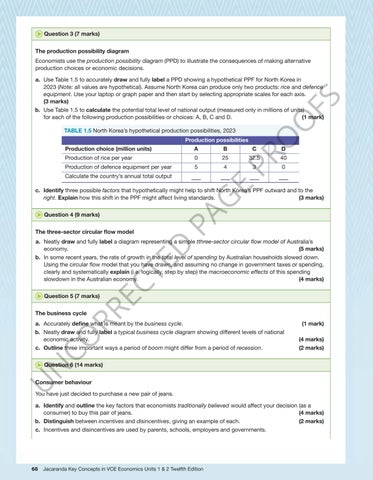“c01ThinkingLikeAnEconomist_PrintPDF” — 2022/7/18 — 23:09 — page 68 — #66
Question 3 (7 marks) The production possibility diagram Economists use the production possibility diagram (PPD) to illustrate the consequences of making alternative production choices or economic decisions.
O
FS
a. Use Table 1.5 to accurately draw and fully label a PPD showing a hypothetical PPF for North Korea in 2023 (Note: all values are hypothetical). Assume North Korea can produce only two products: rice and defence equipment. Use your laptop or graph paper and then start by selecting appropriate scales for each axis. (3 marks) b. Use Table 1.5 to calculate the potential total level of national output (measured only in millions of units) for each of the following production possibilities or choices: A, B, C and D. (1 mark)
O
TABLE 1.5 North Korea’s hypothetical production possibilities, 2023 Production possibilities A
B
Production of rice per year
0
25
Production of defence equipment per year
5
4
D
32.5
40
3
0
E
Calculate the country’s annual total output
C
PR
Production choice (million units)
PA
G
c. Identify three possible factors that hypothetically might help to shift North Korea’s PPF outward and to the right. Explain how this shift in the PPF might affect living standards. (3 marks) Question 4 (9 marks) The three-sector circular flow model
CO RR EC
TE
D
a. Neatly draw and fully label a diagram representing a simple tthree-sector circular flow model of Australia’s economy. (5 marks) b. In some recent years, the rate of growth in the total level of spending by Australian households slowed down. Using the circular flow model that you have drawn, and assuming no change in government taxes or spending, clearly and systematically explain (i.e. logically, step by step) the macroeconomic effects of this spending slowdown in the Australian economy. (4 marks) Question 5 (7 marks)
The business cycle
a. Accurately define what is meant by the business cycle. b. Neatly draw and fully label a typical business cycle diagram showing different levels of national economic activity. c. Outline three important ways a period of boom might differ from a period of recession.
(1 mark) (4 marks) (2 marks)
N
Question 6 (14 marks)
U
Consumer behaviour You have just decided to purchase a new pair of jeans.
a. Identify and outline the key factors that economists traditionally believed would affect your decision (as a consumer) to buy this pair of jeans. (4 marks) b. Distinguish between incentives and disincentives, giving an example of each. (2 marks) c. Incentives and disincentives are used by parents, schools, employers and governments.
68
Jacaranda Key Concepts in VCE Economics Units 1 & 2 Twelfth Edition





















































